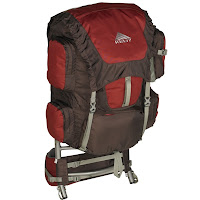Discover the pros and cons of these two common pack designs. Over the past two decades, backpack design has increasingly shifted away from external frames to internal frames. Indeed, it can be difficult these days to even find an external frame design hanging on the wall at your local gear shop. But that doesn’t mean they don’t have their advantages. Here’s a quick look at the pluses and minuses of each style.
- Internal frame packs sit flush against your back, which keeps your overall center of gravity closer to its natural position. When properly adjusted, they shift little in position as you move around. These two factors are a significant advantage for scrambling or other activities that involve regularly shifting your weight and body position.
- They have a large internal capacity, which allows you to keep most, if not all, of your gear protected inside the pack—a plus if you’re bushwhacking and sharp branches might otherwise snag your gear.
- The shoulder straps on most internal frame packs are easy to adjust, making it easier to fine-tune the fit or share the pack with somebody of different height.
- Internal frame packs are compact, which makes it easier to stick it in the trunk or check it as luggage for a flight.
- Most internal frame pack designs feature one or two aluminum stays—long, flat bars located against your back inside the pack that provide rigidity and support. These can be bent and shaped to more precisely match the curvature of your back, increasing comfort.
- There are a few drawbacks to internal frame packs:
- They tend to make for a very sweaty back, thanks to the close, flush fit.
- They tend to be pricier than external frame designs, with most multi-day backpacks running in the $200 to $300-plus range.
- They carry the weight lower than external frame designs, which means that you must lean farther forward to effectively transfer weight to your lower body.
- It can be challenging to strap gear to the outside of the pack in a way that fits securely yet still allows ready access to the contents inside your pack.
- Many feature one or two large internal compartments, and only a few smaller additional pockets for sorting gear (typically a lid compartment and sometimes a pocket on the front of the pack).
- External frame packs sit farther away from your torso, which increases the ventilation—and reduces the sweat factor—against your back. The weight is positioned higher, which allows better load transfer to your lower body and a more upright walking posture. These two aspects makes external frames a good choice for trail walking, but sub-optimal for scrambling—the more top-heavy design is more prone to shifting around as you move.
- They tend to be more affordable than internal frame packs. The Kelty Trekker 65 (pictured), for example, only costs $149.
- It’s easier to securely strap on lots of gear directly to the frame without affecting access to the internal compartments. This offers packing flexibility and improves the accessibility of your gear, but exposes more of your gear to the environment—a drawback for bushwhacking.
- Most offer a multitude of smaller side pockets, which makes it easier to sort, organize, and access your smaller items of gear.
- The shoulder straps on external frame packs are typically more difficult to adjust and often accommodate a narrower range of height.
- They are bigger and bulkier than internal frame designs and can be more challenging for car and plane travel as a result.

